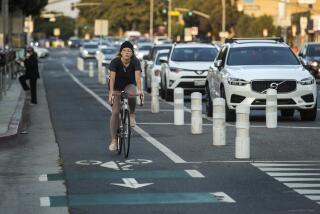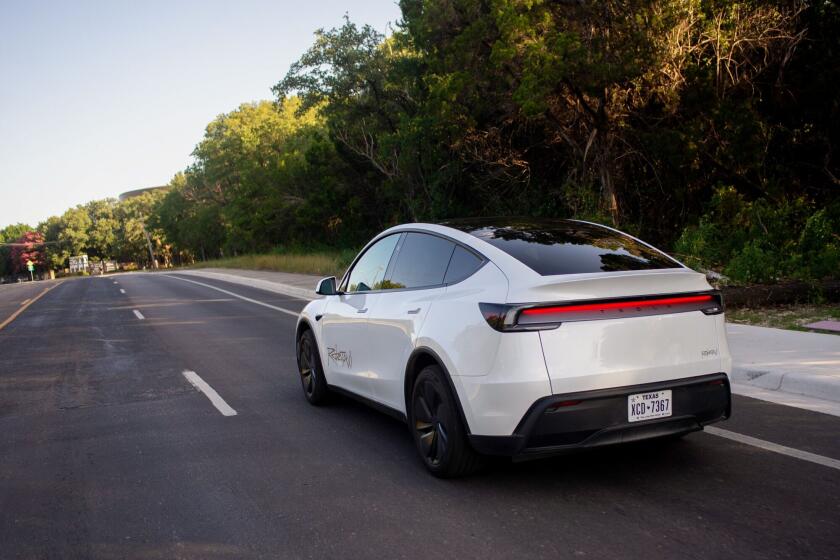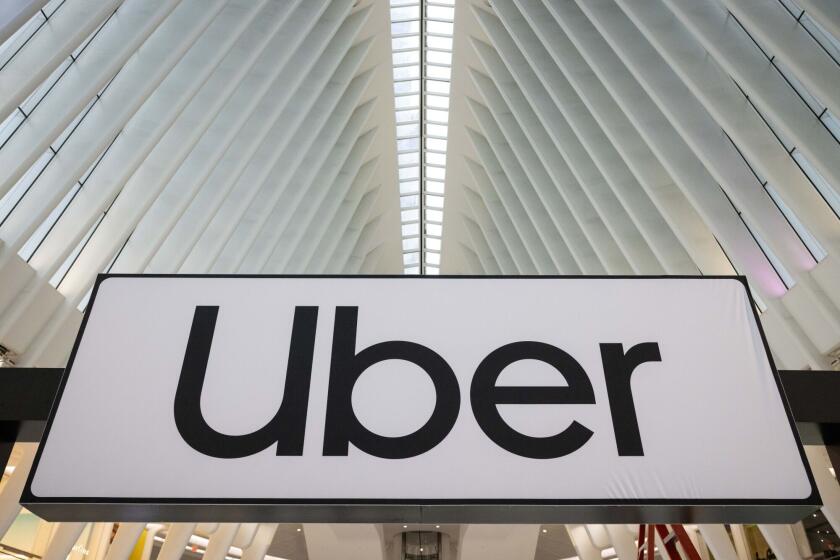Subway planners take sharp turn
- Share via
After trying for three decades to build a subway down Wilshire Boulevard, Los Angeles County transit officials are now considering a radically different route that would send the Westside rail line though Hollywood, West Hollywood and the Beverly Center area.
The new proposed alignment for the “Subway to the Sea” would extend west from the Hollywood/Highland Red Line station, roughly following Santa Monica Boulevard through Beverly Hills.
The new concept is still in its preliminary stages, and the Wilshire alignment remains on the table. But even though officials don’t have funding for the $6-billion project, the new concept has sparked much debate because of how crucial many officials see the subway to easing the Westside’s traffic woes.
The new route would bypass the Miracle Mile and Hancock Park, where opposition remains strong to a subway from residents in the upscale residential district.
At the same time, officials and residents in Hollywood and West Hollywood are rolling out the welcome mat, saying the younger, apartment-living residents in that area would be more likely to take the subway.
“We have a tremendous ridership base that would use it,” said West Hollywood Councilman Jeffrey Prang.
But the new route perplexes some transit experts, who note that bus ridership is much higher on the Wilshire bus lines than on those along Santa Monica Boulevard.
Buses that run along Wilshire attract 64,300 boardings a day, making it the top bus corridor in the Metropolitan Transportation Authority area, which covers much of Los Angeles County. Santa Monica Boulevard’s bus ridership comes in a distant fourth, with 34,900 boardings a day. (Two boardings make up one round trip.)
“The preferred route is where the highest-density corridor is, and that’s definitely along the Wilshire area,” said Genevieve Giuliano, director of the National Center for Metropolitan Transportation Research at USC.
The MTA’s rail planning has come under scrutiny since officials revealed Thursday that the light-rail Exposition Line from downtown to Culver City is expected to cost $145 million, or nearly 23%, more than the original budget called for.
The MTA is examining the pros and cons of each subway route to determine which one deserves further study for an environmental impact report. Officials have not come up with a cost estimate for either alignment. The last detailed study to explore extending the subway westward was done more than 15 years ago. A subway along Wilshire has long been considered a crucial part of the backbone for a rail system in L.A.
When the idea was raised in the early 1980s, residents and businesses rose up to oppose it, citing concerns about construction delays, the danger from underground methane deposits and a possible increase in crime.
But over the last three decades, some of that opposition has dropped as traffic has worsened.
At a recent public meeting, Miracle Mile resident Diana Eisele, 54, recalled how difficult it was for her relatives from London and Rome to navigate L.A.’s mass transit system.
“It’s downright embarrassing trying to get them around the city,” said Eisele, who lives two blocks north of Wilshire on Citrus Avenue.
Eisele also said she has suffered her share of the increasing congestion. She teaches fitness programs for senior citizens around the city. Recently, she had to reschedule the start of her class in West Los Angeles from 9 a.m. to 9:30 a.m. because morning traffic is so unpredictable. Still, she says she is often late.
But others along Wilshire remain opposed to a subway there.
“Subways were developed for vertical cities of the last century. This is a horizontal city,” said Mike Genewick, president of the Windsor Square Neighborhood Assn., known for its stately historic mansions.
He fears that a subway stop at Wilshire and Crenshaw boulevards, and added pressure for development, would “block sunlight and increase crime in single-family residential area.”
The subway is getting a much better reception a few miles north. The MTA’s initial map has the line roughly following Santa Monica Boulevard, but there has been support in the community for the subway to dip south slightly to reach the Beverly Center and Cedars-Sinai Medical Center, two major destinations.
“Places with larger, more expensive homes tend to be more resistant to anything that impacts their neighborhoods,” said West Hollywood’s Prang. In his city, “you have a very receptive community that will welcome mass transportation options.”
Erik Sanjurjo, a member of the Hollywood United Neighborhood Council board, said the proposed shift to Hollywood and West Hollywood makes demographic sense.
“I think there’s a lot of young people who move around that area; that part of the city has a lot of jobs, entertainment, restaurants and theater,” he said. “There’s a lot of activity; the people of that area want a way to move around.”
But in Beverly Hills, some officials seem to favor Wilshire over Santa Monica. Wilshire “gets really clogged in the afternoon; almost at times it becomes like a parking lot,” said Mayor Jimmy Delshad. “On Santa Monica Boulevard, we face a lot of homes.”
Beverly Hills’ mass transit committee has endorsed the Wilshire alignment, which would run through the city’s main commercial district. Nearly 75% of the traffic through that city does not involve a stop there but comes from commuters going to and from downtown L.A. and the Westside, Delshad said.
Even if officials can agree on a route, whether the $6 billion needed to build the subway can be found is a major question. Mayor Antonio Villaraigosa’s aides say they are studying funding scenarios, including “benefit assessment districts” that would levy extra taxes on property owners within half a mile of the line. Another idea is to find a private firm that could build and possibly run the subway.
But some MTA officials say the Subway to the Sea is too expensive and that the money should be spent on smaller transit projects such as busway and freeway expansions.
MTA officials are reviewing comments they received from public meetings last month on the subway and say they expect to present the board with a route recommendation by summer.
--
--
Begin text of infobox
Busiest bus routes
Backers of a subway along Wilshire Boulevard note that the street has far more bus passengers than Santa Monica Boulevard. Here are the top five corridors with the most daily boardings on MTA buses:
Corridor daily boardings*
* Wilshire: 64,300
* Vermont: 57,600
* Western: 40,700
* Santa Monica: 34,900
* Van Nuys: 31,400
(* Does not include subway boardings)
--
Source: Metropolitan Transportation Authority
More to Read
Sign up for Essential California
The most important California stories and recommendations in your inbox every morning.
You may occasionally receive promotional content from the Los Angeles Times.













